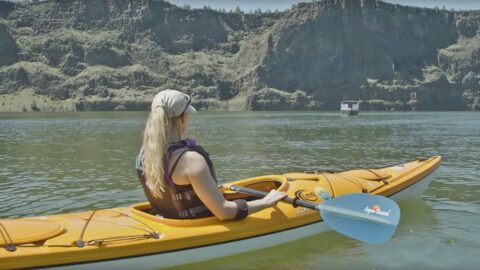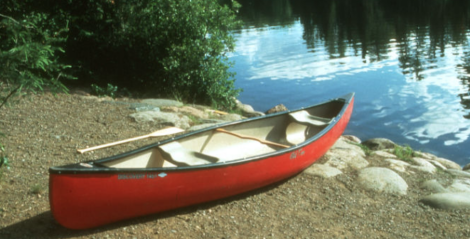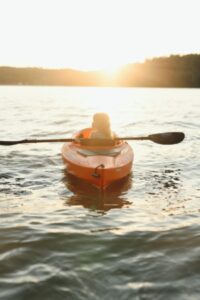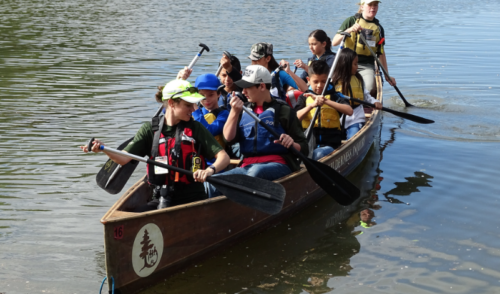Canoeing vs. kayaking — These two recreational water vessels are often confused with each other, and we see the term “canoe” and “kayak” are used interchangeably. Nothing is further than the truth! These two crafts are completely different, handle differently, and have different histories.
One of the only similarities is that they are both boats that require a physical action — paddling — from a person to move, as opposed to the engine-powered or wind-powered boats that we so often see on the water.
Let’s look at all the features of a canoe and a kayak, what it takes to paddle one, and when you should be using each.
Kayak vs Canoe
Although they have a few similarities, a canoe and a kayak are completely different boats. Let’s dissect the different elements of these two water vessels to ensure that you can tell them apart.
The Design
The most obvious difference between a kayak and a canoe is the design of the water vessel. When compared with kayaks, canoes are generally more open, bigger, wider, and heavier.

They are created with open-top frames and have internal hulls that make them heavier and larger than kayaks. In addition, canoes can carry more gear and people. Think of them like the buses of ocean vehicles!
In terms of design, kayaks have a sleek shape and offer limited space. All canoes have open-top whereas kayaks tend to have more variations because they can come in open and closed-top designs. These water vessels are lighter and generally small in size. When you are in a kayak, it is almost like you are the cockpit of a fighter jet.
Common types of canoes are “recreational” and “Canadian”, which tend to be 13 to 17 feet long and sit much higher on the water than a kayak. The design incorporates tall sides and has ample space for the paddler to sit on the bench that runs the width.
The kayak can typically hold one to two people, although some models can hold up to three. Touring kayaks are slimmer, faster, and more nimble when maneuvering around obstacles. Think about them as sports cars! Shorter kayaks, like sea kayaks or kids kayaks, are not as fast but more stable.
Canoe vs. Kayak Paddles
Another significant difference is the paddle that is needed to propel a canoe or a kayak. Canoes use a paddle with a single blade, and the person paddling is required to switch sides with paddling a

canoe.
Kayaks are closer to the water, and kayak paddles have double blades that require a twisting motion where each blade enters the water in turn.
When canoeing, you paddle on one side at a time. With kayaking, you are often alternating constantly — right, left, right, left.
Stability Difference Between Kayaks and Canoes
This is a tough one.
With their wider, heavier, and longer shape, canoes offer more starting stability than a kayak, very generally speaking. Deeper and wider hulls on a canoe enable you to carry gear and large loads for longer trips. However, a wider hull and a larger size make it a hassle to maneuver a canoe. Aluminum canoes, specifically, are considered pretty stable.

However, because you sit so high in a canoe, it can be tippy. Sitting low in a canoe makes it quite stable. With time and practice, you can become pretty confident canoeing.
Over the years, kayaks have dramatically improved in stability. Despite being smaller, slimmer, and lighter, kayaks are now designed to easily glide through the water and are much easier to maneuver.
Wide “sea kayaks” are quite stable because you sit to low to the water. As with any vessel, the narrow and longer it is, the more prone to tips it will be.
Regardless of how stable you think your vessel will be, a lifejacket should always be used with both a canoe and a kayak.
The Seats
Launching a canoe from a beach or dock is much easier because of the wide opening. Canoers kneel or sit in the boat that usually has benches across its width, while kayakers sit lower in the hull and stretch out their legs in front of them. Kayakers often have a more contoured seat to sit in.
Kayaks also have several types of designs. A closed-deck kayak means you’ll sit in the cockpit and use a spray skirt to prevent the water from getting in. An open-top kayak means you’ll simply sit on top of the kayak, and these kayaks often have a self-bailing opening to keep the water out.
Keep in mind that you’ll need training if you’re using a closed-deck kayak with a spray skirt. This is because if you capsize, you’ll need to bail yourself out and escape the hatch unless you can Eskimo roll.
The Eskimo roll is a vital skill for any kayaker. It allows you to right your kayak if it capsizes. The roll is fairly simple to execute, but it does require some practice, so you might want to get some proper training.
Fishing In A Canoe And Kayak
Even though you can fish in both vessels, there are some variations in how you can fish from a canoe compared to a kayak. Generally, people consider canoes as the better choice for fishing because these boats can carry more people and store fishing gear.
In addition, the wide hulls of a canoe can keep the craft more stable compared to a kayak.

However, fishing kayaks are all the rage these days. They are wider and sit lower in the water, so they are way less tippy and you can even stand on some of them comfortably.
These specially-designed fishing kayaks are better at managing rough waters compared to fishing canoes. A major drawback of kayaks is their smaller, compact size can become uncomfortable on longer fishing expeditions.
Fishing kayaks are designed to accommodate solo fishermen and have minimal space to carry gear.
When Should You Use a Kayak versus a Canoe?
If you’re up for a water adventure, you might wonder which watercraft would suit you best. Kayaks are better for solo or double paddling, while canoes can fit two or three people comfortably.
Kayaks are also more easily maneuvered and handled, and they typically weigh less than canoes, so it would be easier for a solo paddler to handle them.
Kayaks can also cover long distances once you’ve got the paddling technique down pat. Kayaking expeditions can last hundreds, if not thousands of miles. If you are planning a few-hour paddle, a kayak might be more suited, while a canoe will be perfect for a group outing around a lake or a longer trip.
Canoes are far better when you want to carry lots of gear, such as a canoe camping trip.
Common Activities, Which is Better: Canoe vs. Kayak
Recreational Paddling (small lake)
I prefer a canoe for paddling around a small lake. You can fit children in them and, as long as the lake isn’t rough, explore pretty easily.
Recreational Paddling (larger lake or river)
I like a kayak on larger bodies of water, or any water with a current, because I find them more stable and easier to control.
Backpacking and Backcountry Exploring
I definitely prefer a canoe when headed into remote country, and backcountry exploring which may involve backpacking, overnights or portages. Canoes hold more gear and are better for portaging.
Fishing
Both are good for fishing, but I give an edge to a kayak. Fishing-specific kayaks have gotten really good. If you are taking others, though, canoes will fit more people.
Long-Distance or Coastal Touring
The right kayak is great for a coastal area, because of its maneuverability and ability to cover lots of surface are quickly. As long as you don’t need to portage or carry gear, use kayaks for exploring coastlines or longer distances.
Canoe and Kayak Frequently Asked Questions
Canoe vs Kayak – Which is more difficult?
If you are a new paddler, the short answer is that canoeing is harder to pick up than kayaking. Canoes are more difficult to steer and turn, have a higher center of gravity, and are more vulnerable to wind and rough waters. Kayaks are pretty easy to learn, especially if you are using a wider, sea kayak.
Is a canoe or kayak tippier?
It depends. You sit higher in a canoe, so that creates more chance of feeling side-to-side tippy. However, if you sit low in a canoe, it will be pretty stable. Kayak stability depends on how long the kayak is relative to its width. Kayaks can come in all shapes, styles, and sizes. Eddyline kayaks, for example, makes 18 different kayak models across 4 separate categories. Shorter, wider kayaks are quite stable.
Kayak or canoe – which is more comfortable?
Canoes tend to be more comfortable compared with kayaks for short distances. In addition, canoes are also more convenient for fishing because you can stash more things away. It comes with ample storage space to bring extra gear, food, and coolers. Not that you may want to use a hard-sided water bottle because it will likely roll around and get banged-up.
Kayaks are slightly more difficult to load and unload because of their slim design and if they are closed-deck.
Final Thoughts
Whichever craft you have, paddling is so much fun! There’s nothing like being in the open ocean exploring new sights or out alone on the lake enjoying some precious me time. Be sure always to wear a personal flotation device, and have fun!






